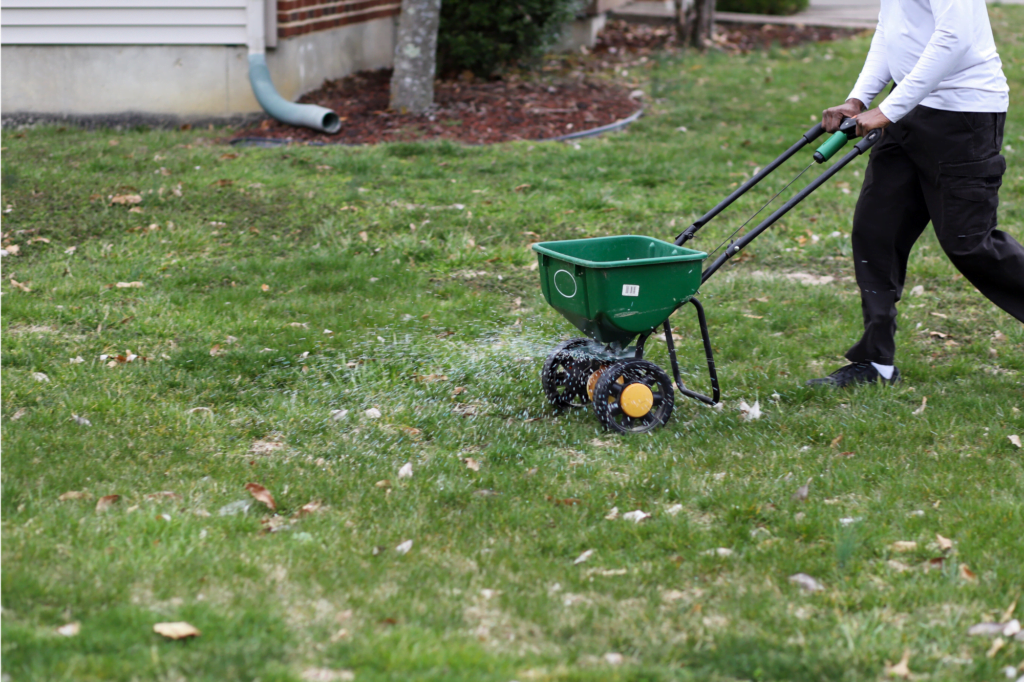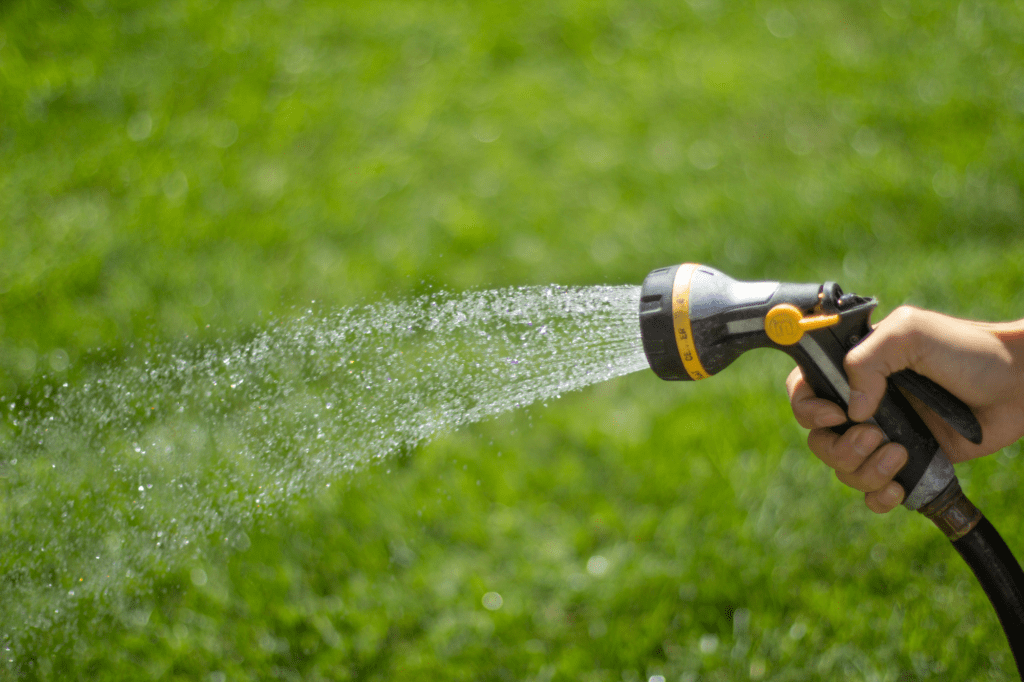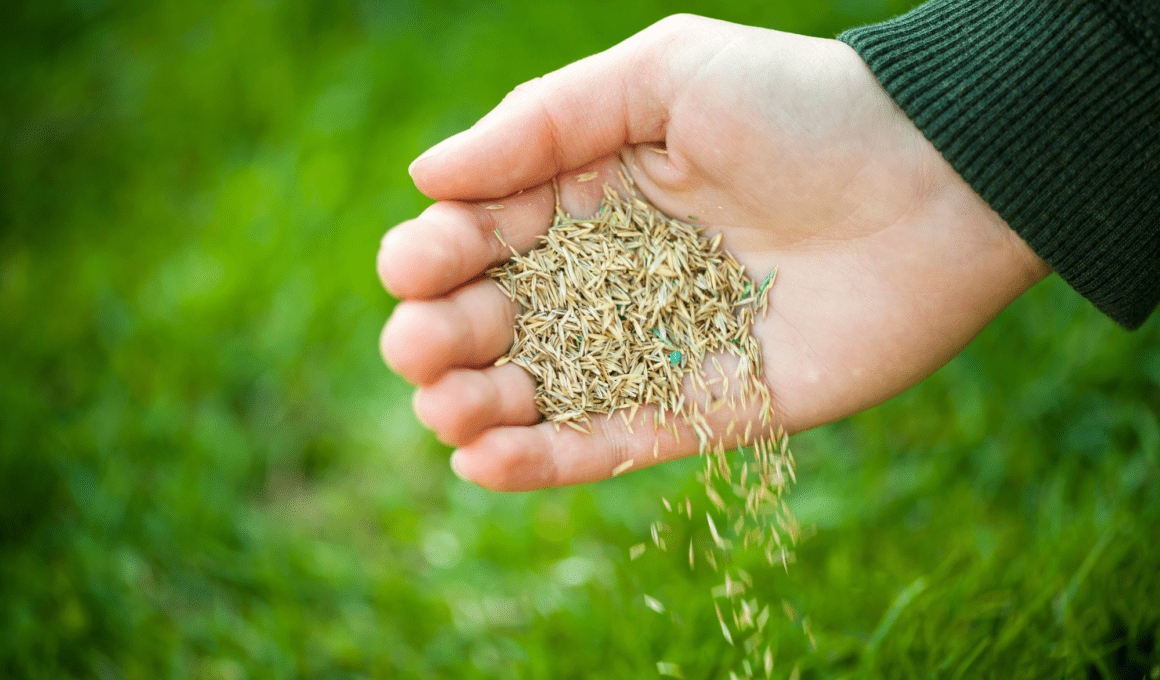Quick Summary
- Assess the condition of the lawn and identify thin or bare areas and potential obstacles.
- Prepare the soil by removing debris and loosening it with a rake or garden tiller.
- Choose the right grass seed based on climate, soil type, and desired appearance.
- Seed and fertilize the lawn by spreading the seed evenly and applying a layer of fertilizer.
Assess Your Lawn’s Condition
Take a quick look at your lawn to see if it’s ready for some grass seed action! Before you dive into planting grass seed on your existing lawn, it’s important to assess its condition. By evaluating the methods and identifying any potential problems, you can ensure the success of your grass seed project while keeping safety in mind. Start by examining the overall health of your lawn. Look for bare patches, thinning areas, or weed infestations. These could be signs of an unhealthy lawn that may require additional steps before planting grass seed. Next, check the soil quality. Is it compacted or too sandy? Poor soil conditions can hinder the growth of grass seed, so it’s crucial to address any soil issues beforehand. Additionally, keep an eye out for any drainage problems. Standing water or areas prone to flooding can prevent grass seed from taking root properly. It’s important to fix these drainage issues to ensure the success of your grass seed project. By carefully evaluating your lawn’s condition and identifying potential problems, you can take the necessary steps to prepare your existing lawn for grass seed planting. This will help you achieve a lush and healthy lawn that you can enjoy for years to come.Prepare the Soil
To prepare the soil for planting grass seed on your existing lawn, you’ll need to start by removing any weeds and debris that may be present. This will ensure that the new grass seed has a clean and clear space to grow. Next, it’s important to loosen any compacted soil to improve drainage. This can be done by aerating the lawn or using a garden fork to break up the soil.Remove weeds and debris
Clear out any pesky weeds and debris to make way for your beautiful new lawn. Follow these steps to ensure a safe and effective process:- Start by manually removing any large weeds or plants from the area. Use a garden fork or spade to dig out the roots, ensuring they’re completely removed.
- Next, use a rake to remove any smaller weeds, dead grass, or debris from the surface of the soil. This’ll help create a clean and even base for your new grass seed.
- Consider using an herbicide to treat any persistent weeds that may regrow. Be sure to choose a herbicide that’s safe for use on lawns and follow the instructions carefully to avoid harming the surrounding plants.
- Lastly, dispose of the weeds and debris properly to prevent them from regrowing or spreading to other areas of your lawn. Bag them up and dispose of them in accordance with local regulations.
Loosen compacted soil and improve drainage
Start by breaking up and loosening the compacted soil to improve drainage and create a healthier foundation for your new, lush yard. This step is crucial in ensuring that your grass seed will have the best chance of thriving. Compacted soil can prevent water from being absorbed properly, leading to poor growth and potential water runoff. By improving the soil quality and increasing water absorption, you are setting the stage for a successful lawn. To do this, use a garden fork or aerator to gently break up the soil surface. This will allow air, water, and nutrients to penetrate deeper into the ground. Aim to create small holes or channels throughout the lawn to promote better root development. Remember to take your time and work systematically, focusing on areas that feel particularly compacted. Once you’re done, rake the loosened soil to remove any debris or clumps. This will provide a smooth surface for the next steps in the process.| Loosening Soil Tips | Safety Precautions |
|---|---|
| Use a garden fork or aerator to break up the soil | Wear gloves to protect your hands |
| Work systematically, focusing on compacted areas | Use proper body mechanics to avoid strain |
| Create small holes or channels throughout the lawn | Take breaks as needed to prevent overexertion |
| Rake the loosened soil to remove debris | Stay hydrated and avoid working in extreme weather |
Choose the Right Grass Seed
When selecting the appropriate grass seed for your existing lawn, it’s crucial to consider factors such as shade tolerance, drought resistance, and soil type. Choosing the right grass seed is essential to ensure a healthy and vibrant lawn. Here are three key factors to consider when selecting grass seed:- Types and Characteristics: There are various types of grass seed available, each with its own set of characteristics. Some grasses are better suited for sunny areas, while others thrive in shaded spots. It’s important to choose a grass seed that matches the specific conditions of your lawn. Additionally, consider the desired appearance and maintenance level of the grass, as different grasses have different growth rates and textures.
- Factors to Consider: Take into account the specific requirements of your lawn, such as the amount of foot traffic it receives, the climate in your region, and the soil conditions. Some grasses are more tolerant of heavy use, while others are better suited for dry or wet climates. Understanding these factors will help you select a grass seed that will thrive in your particular environment.
- Safety Considerations: When choosing grass seed, it’s important to prioritize safety. Avoid using grass seed that has been treated with harmful chemicals or pesticides, especially if you have children or pets who frequently use the lawn. Opt for organic or natural grass seed options to minimize potential health risks.
Seed and Fertilize
Now that you’ve chosen the right grass seed for your existing lawn, it’s time to move on to the next step: seed and fertilize. This is a crucial part of the process as it ensures that your new grass seeds have the nutrients they need to grow and thrive. To begin, you’ll want to prepare the soil by raking it lightly to loosen the top layer. This will help the seeds make contact with the soil and promote germination. Next, evenly spread the grass seed across the entire lawn using a spreader or your hands. Be sure to follow the recommended seeding rate provided on the seed packaging to ensure proper coverage.
Once the seeds are spread, it’s time to fertilize. Choose a fertilizer that’s specifically formulated for new grass seed and apply it according to the instructions on the package. This will provide the necessary nutrients for your new grass to establish strong roots and grow healthy.
After seeding and fertilizing, the most important step is to water your lawn properly. Watering techniques play a crucial role in the success of your grass seed. It’s best to water lightly but frequently, keeping the soil consistently moist until the new grass is established.
By following these steps and paying attention to seed selection and watering techniques, you’ll be well on your way to a lush and beautiful lawn.
Next, evenly spread the grass seed across the entire lawn using a spreader or your hands. Be sure to follow the recommended seeding rate provided on the seed packaging to ensure proper coverage.
Once the seeds are spread, it’s time to fertilize. Choose a fertilizer that’s specifically formulated for new grass seed and apply it according to the instructions on the package. This will provide the necessary nutrients for your new grass to establish strong roots and grow healthy.
After seeding and fertilizing, the most important step is to water your lawn properly. Watering techniques play a crucial role in the success of your grass seed. It’s best to water lightly but frequently, keeping the soil consistently moist until the new grass is established.
By following these steps and paying attention to seed selection and watering techniques, you’ll be well on your way to a lush and beautiful lawn.
Water Properly
To ensure a thriving and vibrant lawn, it’s important to water your newly seeded and fertilized area consistently and gently, allowing the soil to remain consistently moist for optimal growth. Proper watering techniques are crucial in this process. When watering, make sure to use a gentle spray or sprinkle setting on your hose or sprinkler to prevent disturbing the seeds or causing them to wash away. It’s also important to water the area evenly, ensuring that every part of the lawn receives sufficient moisture.
To prevent water runoff and promote deep root growth, water the lawn in multiple short sessions rather than one long session. This allows the water to penetrate the soil gradually, preventing it from pooling or running off the surface. Additionally, avoid watering during the hottest parts of the day when evaporation rates are high. Instead, water in the early morning or late afternoon when temperatures are cooler and the water has a better chance of being absorbed by the soil.
Remember to monitor the moisture level of the soil regularly. Stick your finger into the soil to check if it feels moist to a depth of about 1 inch. If it feels dry, it’s time to water again. Overwatering can be just as harmful as underwatering, so it’s important to find the right balance.
By following these proper watering techniques and preventing water runoff, you’ll give your newly seeded lawn the best chance to grow and thrive.
When watering, make sure to use a gentle spray or sprinkle setting on your hose or sprinkler to prevent disturbing the seeds or causing them to wash away. It’s also important to water the area evenly, ensuring that every part of the lawn receives sufficient moisture.
To prevent water runoff and promote deep root growth, water the lawn in multiple short sessions rather than one long session. This allows the water to penetrate the soil gradually, preventing it from pooling or running off the surface. Additionally, avoid watering during the hottest parts of the day when evaporation rates are high. Instead, water in the early morning or late afternoon when temperatures are cooler and the water has a better chance of being absorbed by the soil.
Remember to monitor the moisture level of the soil regularly. Stick your finger into the soil to check if it feels moist to a depth of about 1 inch. If it feels dry, it’s time to water again. Overwatering can be just as harmful as underwatering, so it’s important to find the right balance.
By following these proper watering techniques and preventing water runoff, you’ll give your newly seeded lawn the best chance to grow and thrive.
Can Over Fertilization Cause the Need to Plant Grass Seed on an Existing Lawn?
Over fertilization can have negative consequences, leading to the need to plant grass seed on an existing lawn. A reverse over fertilized lawn can become weak, prone to diseases, and may even experience grass burn. To restore its health, reseeding is a recommended solution to promote new growth and rejuvenate the lawn.
Maintain and Care for Your Lawn
Take a stroll through your yard and admire the lush, green expanse that you’ve nurtured and cared for. Your well-maintained lawn is a testament to your dedication and hard work. To keep it looking its best, there are a few key tasks you should regularly perform. Here are four essential steps to maintain and care for your lawn:- Lawn mowing: Regular mowing is crucial to keep your grass healthy and vibrant. Set your mower blades at the appropriate height, usually around 2-3 inches, to prevent scalping and promote root growth. Remember to mow in different directions each time to avoid creating ruts.
- Lawn aeration: Over time, soil can become compacted, hindering the flow of air, water, and nutrients to the grass roots. Aerating your lawn helps alleviate compaction and promotes better absorption. You can use a manual or mechanical aerator to create small holes in the soil, allowing your grass to breathe.
- Watering: Proper watering is essential for a thriving lawn. Water deeply and infrequently, aiming for about an inch of water per week. This encourages the roots to grow deeper, making your lawn more drought-resistant. Water in the early morning to minimize evaporation.
- Fertilizing: Regularly feeding your lawn with appropriate fertilizers ensures it receives the necessary nutrients for growth and resilience. Choose a slow-release fertilizer and follow the instructions carefully to avoid over-application, which can harm the grass.
Monitor Growth and Make Adjustments
As you continue to nurture your green oasis, you’ll discover the importance of closely monitoring your lawn’s growth and making necessary adjustments along the way. Ensuring the health and vitality of your lawn requires diligent observation and timely action. To effectively monitor the growth of your grass, there are various methods you can employ. Regularly inspect your lawn for any signs of disease, pests, or weed infestation. Keep an eye out for areas with uneven growth or discoloration. Additionally, pay attention to the amount of water your lawn receives and adjust watering accordingly. By monitoring these factors closely, you can catch any issues early on and take appropriate measures to address them. When it comes to making adjustments, there are several techniques you can employ to maintain a healthy lawn. If you notice areas with sparse growth, overseeding can help fill in the gaps. This involves spreading additional grass seed over the existing lawn to promote thicker coverage. Adjusting your mowing height can also have a significant impact on the overall health of your lawn. Cutting the grass too short can stress and weaken it, while keeping it too long can encourage disease and pests. Regularly aerating the soil can improve its ability to absorb water and nutrients, promoting healthy growth. By implementing these monitoring methods and adjusting techniques, you can ensure that your lawn remains lush and vibrant.Enjoy a Beautiful and Healthy Lawn
Regularly fertilize your lawn and maintain proper lawn care practices to ensure its health and beauty. By providing the necessary nutrients and following proper maintenance routines, you can enjoy a vibrant and lush lawn. Sit back, relax, and take pride in the stunning results of your efforts as you enjoy your beautiful and healthy outdoor space!Regularly fertilize and maintain proper lawn care practices
To keep your lawn healthy and vibrant, make sure you’re fertilizing regularly and staying on top of proper lawn care practices. Regular lawn fertilization is essential for providing the necessary nutrients to promote strong root growth and lush, green grass. Choose a high-quality fertilizer that suits your lawn’s specific needs and follow the instructions carefully. Apply the fertilizer evenly across your lawn, using a spreader for better coverage. Additionally, proper lawn maintenance is crucial for ensuring the overall health of your lawn. This includes mowing at the correct height, watering deeply and infrequently, and removing any weeds or debris. Regularly inspect your lawn for signs of pests or diseases and take appropriate action immediately. By consistently fertilizing and maintaining your lawn, you can enjoy a beautiful and safe outdoor space for your family and pets.Sit back and enjoy your vibrant, lush lawn!
Now that you have fertilized your lawn and implemented proper care practices, it’s time to sit back and enjoy the fruits of your labor. Your vibrant, lush lawn is just a few steps away! To ensure the longevity and beauty of your grass, here are some tips for ongoing maintenance:- Regular watering: Adequate hydration is crucial for maintaining a healthy lawn. Water deeply and infrequently to encourage deep root growth.
- Mowing techniques: Set your mower blades at the proper height to avoid scalping the grass. Regularly sharpen the blades for clean cuts and avoid cutting more than one-third of the grass height at a time.
- Weed control: Keep an eye out for pesky weeds and promptly remove them. Consider using organic weed control methods to protect the environment and maintain a safe space for your family.
- Regular feeding: Continue to fertilize your lawn according to the recommended schedule. This will provide essential nutrients for robust growth and a vibrant, lush appearance.
| Tips for Vibrant Lawn Maintenance | Tips for a Lush Lawn |
|---|---|
| Water deeply and infrequently | Regularly sharpen mower blades |
| Keep an eye out for weeds | Avoid cutting more than one-third of grass height |
| Use organic weed control methods | Continue regular fertilization |








